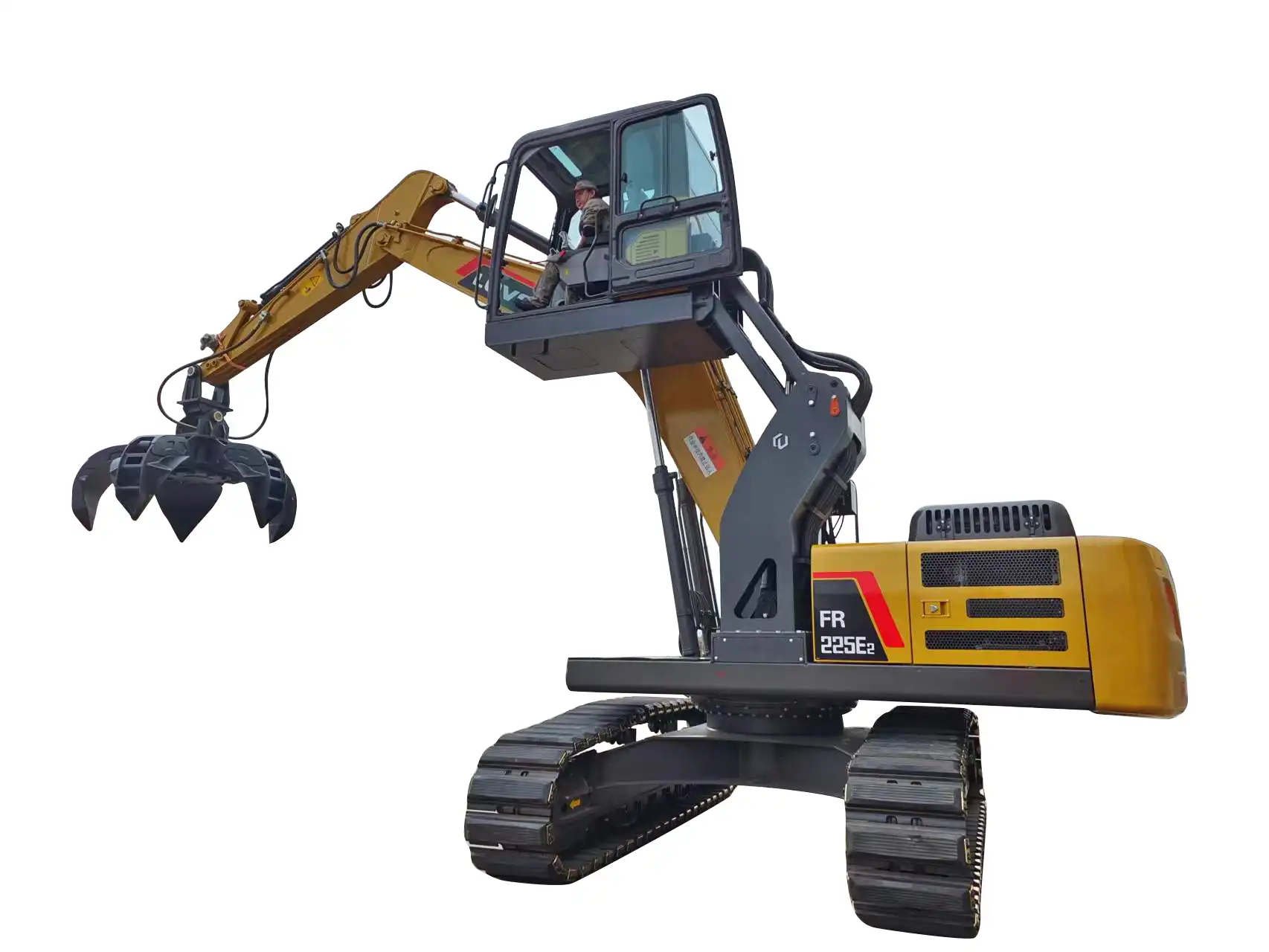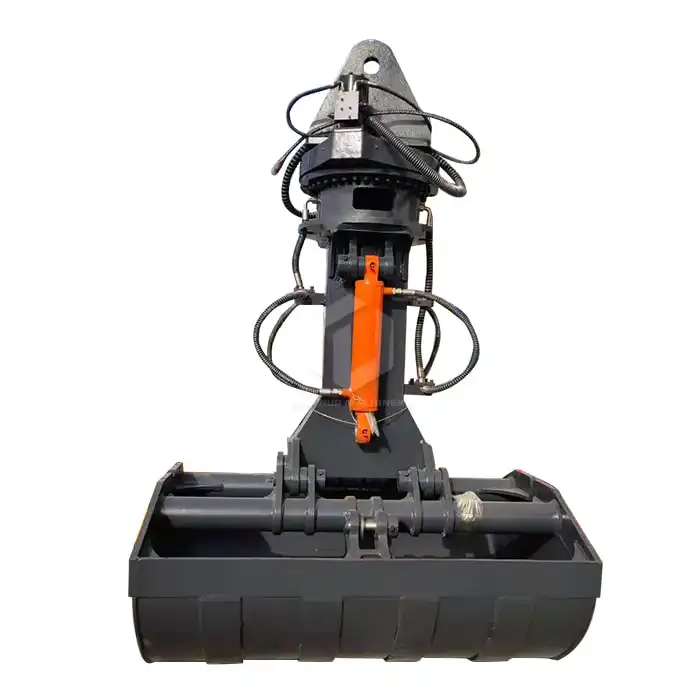How to calculate excavator bucket capacity?
Calculating the capacity of an excavator bucket is crucial for optimizing efficiency and productivity in various industries, including railway construction, mining, and demolition. Whether you're a construction company owner, purchasing manager, or engineer, understanding bucket capacity helps in making informed decisions about equipment selection and project planning. This comprehensive guide will walk you through the process of determining bucket capacity, ensuring you can maximize your machinery's performance while maintaining reasonable cost control.
What is the bucket capacity of an excavator?

Excavator Bucket Capacity
The bucket capacity of an excavator refers to the volume of material it can hold in a single scoop, directly impacting its performance and efficiency. Measured in cubic meters or cubic yards, this specification influences the machine’s workload, cycle time, and fuel consumption. A larger bucket capacity enables the excavator to move more material per pass, reducing the number of cycles required to complete a task, which can significantly boost productivity on construction, mining, and excavation sites. However, bucket size must be carefully matched to the excavator’s operating weight, hydraulic power, and intended application to ensure optimal performance without overloading the machine or compromising stability. Factors such as bucket shape, material density, and digging conditions also play a crucial role in determining effective capacity and operational efficiency.
Factors Influencing Bucket Capacity
Several factors influence the effective capacity of an excavator bucket, each playing a crucial role in determining its performance and suitability for different tasks:
- Material density: The type and weight of the material being handled significantly impact bucket capacity. Heavier materials, such as wet clay, compacted soil, or dense gravel, require a smaller bucket to prevent overloading and ensure efficient digging. In contrast, lighter materials like dry sand, loose soil, or wood chips can be handled with a larger bucket, maximizing productivity per cycle.
- Bucket design: Excavator buckets come in various shapes and styles, each optimized for specific applications. General-purpose buckets are designed for a balance between capacity and strength, while heavy-duty rock buckets feature reinforced edges and thicker steel to withstand abrasive conditions. Grading buckets, ditch-cleaning buckets, and high-capacity buckets further cater to specialized excavation and material-handling needs. The choice of bucket shape, cutting-edge type, and side-wall angle also influences the actual fill factor and digging efficiency.
- Machine stability: The excavator’s size, operating weight, and hydraulic capacity determine the maximum bucket size it can safely handle. A larger bucket increases the load on the boom, arm, and undercarriage, affecting stability, maneuverability, and wear on machine components. Manufacturers specify recommended bucket capacities based on the excavator’s lifting capacity to ensure safe and efficient operation without risking tipping or excessive strain on hydraulic systems.
- Soil and Worksite Conditions: Digging in compacted or rocky terrain demands greater breakout force, which may limit the practical bucket size compared to working in loose or soft soils. Additionally, environmental factors such as moisture content, embedded debris, and excavation depth can influence bucket performance.
- Cycle Time and Efficiency: The optimal bucket size balances material volume with cycle speed. An oversized bucket may reduce the number of scoops needed but can slow down cycle times due to increased load weight and longer dump times. Conversely, a smaller bucket enhances speed and precision but may require more cycles to complete a task.
Importance of Proper Capacity Selection
Choosing the right bucket capacity is essential for achieving optimal performance and cost-effectiveness. An undersized bucket may lead to increased cycle times and reduced productivity, while an oversized bucket can strain the machine and compromise safety. By accurately determining the required capacity, you can ensure your excavator operates at peak efficiency while maintaining controllable product quality.
How to calculate bucket size?

Steps to Measure Bucket Dimensions
To calculate the size of an excavator bucket, follow these steps:
- Measure the Bucket Width:
Using a tape measure, determine the bucket’s width at its widest point, typically from one sidewall to the other. This measurement helps assess material-handling capability and compatibility with trenching or grading requirements. - Determine the Bucket Depth:
Measure the distance from the cutting edge (front lip) to the back plate of the bucket. This depth indicates how much material the bucket can scoop in a single pass and influences digging efficiency. - Measure the Bucket Height:
Measure from the lowest point of the bucket (bottom or cutting edge) to the highest point of the top edge. This dimension is crucial for calculating the bucket’s overall volume and understanding its ability to carry different material loads. - Measure the Bucket Radius (Optional):
If needed, measure the radius from the bucket pivot point to the cutting edge. This helps determine the bucket’s reach and potential digging depth. - Check the Bucket’s Shape and Profile:
Some buckets have a more squared-off design, while others feature a rounded or tapered profile. These variations affect the actual carrying capacity and digging efficiency. - Convert and Record Measurements:
Ensure all measurements are recorded in consistent units, preferably meters or millimeters. If necessary, convert them to cubic meters or cubic yards when calculating volume.
Accounting for Bucket Shape
Different bucket shapes require slightly different calculation methods:
- Standard buckets: Use the basic length x width x height formula.
- Tapered buckets: Calculate the average width before multiplying.
- Curved buckets: Consider using 3D modeling software for more accurate results.
Applying Fill Factors
The fill factor is a crucial component in determining the practical capacity of an excavator bucket. This factor accounts for the fact that buckets are rarely filled to their maximum geometric capacity due to material characteristics and operator techniques. Typical fill factors range from 0.8 to 1.0, with lower values for cohesive materials like clay and higher values for loose materials like sand.
What is the formula for bucket capacity?

Basic Bucket Capacity Formula
The fundamental formula for calculating excavator bucket capacity is:
Capacity = Width x Depth x Height x Fill Factor
Where all dimensions are in meters, and the result is in cubic meters.
Advanced Calculations for Specific Bucket Types
For more complex bucket shapes, additional formulas may be necessary:
- Trapezoidal buckets: Use the average of the top and bottom widths in your calculations.
- Rounded buckets: Incorporate the bucket's radius into the formula for more accurate results.
- Specialized attachments: Consult manufacturer specifications for custom calculation methods.
Practical Examples and Troubleshooting
Let's consider a practical example:
An excavator bucket measures 1.5m wide, 1.2m deep, and 0.9m high. Assuming a fill factor of 0.85 for mixed soil conditions, the capacity would be:
1.5m x 1.2m x 0.9m x 0.85 = 1.377 cubic meters
If you encounter discrepancies between calculated and actual capacities, consider factors such as material compaction, bucket wear, and operator technique. Regular calibration and maintenance of your excavator attachments can help ensure consistent performance and accurate capacity measurements.
FAQ
1. What is the standard bucket capacity for different excavators?
- Mini excavators (1-6 tons): 0.01 to 0.3 m³ (0.01 to 0.4 yd³)
- Medium excavators (7-30 tons): 0.3 to 1.5 m³ (0.4 to 2 yd³)
- Large excavators (30+ tons): 1.5 to 6 m³ (2 to 8 yd³)
- Mining excavators (100+ tons): 10+ m³ (13+ yd³)
2. How do I choose the right bucket capacity for my excavator?
Consider the excavator’s operating weight, hydraulic power, material type, and job requirements. Overloading a bucket can cause machine instability and increased wear on components.
3. What is the fill factor, and why does it matter?
The fill factor is the efficiency rate at which a bucket is filled with material. It varies depending on material type and bucket shape, typically between 80% and 110%. A well-designed bucket can improve productivity by achieving a higher fill factor.
4. How does bucket capacity impact fuel efficiency?
A properly sized bucket can optimize cycle times and reduce fuel consumption. A bucket that is too large may strain the excavator, increasing fuel usage, while a bucket that is too small requires more cycles to complete the job, also consuming extra fuel.
At Tiannuo, we specialize in providing top-tier excavator buckets designed to enhance your excavation efficiency and reliability. Our excavator buckets are crafted from high-strength wear-resistant steel, ensuring durability and longevity. With a capacity ranging from 0.1 to 5.0 cubic meters and a weight between 100 and 2000 kg, our buckets are versatile and can handle a wide array of tasks. The width varies from 500 to 2000 mm, and customization is available to meet your specific requirements. Our buckets are compatible with various excavator models and can be attached using either pin-on or quick coupler methods. Safety is a priority, with reinforced edges and wear plates included.
Understanding how to calculate excavator bucket capacity is essential for optimizing your operations and making informed equipment decisions. By applying these methods and formulas, you can ensure that your machinery is properly matched to your project requirements, leading to improved efficiency and cost-effectiveness.
For more information on high-quality excavator buckets and attachments tailored to your specific needs, don't hesitate to contact us at arm@stnd-machinery.com, rich@stnd-machinery.com, or tn@stnd-machinery.com. Our team of experts is ready to assist you in finding the perfect solution for your construction, mining, or demolition projects.
References
1. Johnson, R. (2021). Excavator Bucket Capacity: Principles and Calculations. Construction Equipment Journal, 45(3), 78-85.
2. Smith, A. & Brown, T. (2020). Optimizing Excavator Performance through Bucket Selection. Mining Technology Review, 18(2), 112-124.
3. Zhang, L. et al. (2022). Advanced Methods for Calculating Excavator Attachment Capacities. Journal of Construction Engineering, 37(4), 301-315.
4. Miller, E. (2019). The Impact of Bucket Capacity on Excavator Efficiency. International Journal of Civil Engineering, 12(1), 45-58.
5. Thompson, K. (2023). Excavator Bucket Design: Innovations and Capacity Considerations. Heavy Equipment Technology, 29(3), 201-215.
6. Anderson, P. & Lee, S. (2021). Fill Factors and Their Influence on Practical Bucket Capacities. Geotechnical Engineering Practice, 15(2), 89-102.
About Author: Arm
Arm is a leading expert in the field of specialized construction and railway maintenance equipment, working at Tiannuo Company.









